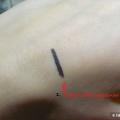What can a nursing mother eat after childbirth?
The long-awaited baby was born - and soon a very urgent and very important question arises in front of the young mother: what can you eat after giving birth, and what not? Diet restriction during this period is directly related to the quality of breast milk with which a woman feeds her baby. He can react to some foods with allergies in the form of rashes, to others by intestinal colic, and to others by nervous overexcitation, sleep disturbances and appetite disorders. And the mother herself needs to make up for the lack of minerals and vitamins that were spent on the baby during pregnancy. Correct, balanced, competent nutrition will quickly restore her strength and will contribute to the full development of the child. There are several lists of allowed and prohibited foods in the first week and first two months after giving birth.
Still drinking water is all that a woman can do on the first day after a cesarean section
First week
A woman's diet in the first 3-5 days after childbirth will depend on how the process went in general. If there were any complications and difficulties, not everything can be started to eat immediately after the birth of the baby. These days, you need to adhere to certain fairly strict dietary restrictions. And the relatives of a young mother should know about this, so as not to bring products to the maternity hospital that will spoil lactation or affect the condition of the child.
If there are stitches on the crotch
- you can not eat foods rich in fiber: black bread, raw fruits, vegetables, bran;
- you can eat kashi (preferably on water), first courses, dairy products (in limited quantities).
This will provide at least some temporary stool retention, which means it will avoid the divergence of the seams, which will contribute to their early healing.
After a cesarean section
- on the first day you can not eat anything, you can only drink water without gas;
- on the second day, it is already allowed to eat a little broth (low-fat), meat (in the form of mashed potatoes), apples (preferably baked), cereals (on water).
To improve her condition after childbirth, a woman should adhere to these recommendations in order to recuperate as soon as possible. If complications were avoided, after discharge from the hospital, a young mother needs to be very attentive to her own diet at home, following the recommendations of doctors.

Vegetable stew on the menu of a nursing mother may be present as early as the first month after childbirth.
First month
The most serious test awaits a young mother in the first month after giving birth, because the restrictions on what you can eat and what you cannot eat will be the most extensive. Along with this, her diet should be varied and balanced so that she can recuperate, normalize stools and establish lactation. In the first month after the appearance of the baby, a young woman can safely eat foods such as:
- still mineral water;
- rosehip broth;
- lightly brewed black tea;
- kefir;
- hard cheeses;
- mashed potatoes;
- porridge on the water, excluding rice;
- beet salad with normal child tolerance of this product;
- vegetable stew;
- low-fat soup;
- boiled fish fillet;
- steamed or boiled meat: lean pork (tenderloin), beef, poultry (white meat);
- green baked apples;
- ripe banana (but only 1 per day).
In parallel with this, a young mother needs to try to avoid colic and allergies in her baby. And for this purpose, nutritionists and pediatricians recommend that in the first month after childbirth, all breastfeeding mothers refrain from eating foods such as:
- fruit juices;
- chocolate;
- coffee;
- milk;
- baking;
- bakery;
- spices;
- very salty;
- too spicy;
- a lot of fried;
- canned food;
- smoked meat;
- red and black caviar;
- raw vegetables;
- Exotic fruits;
- any kind of tomatoes, cabbage, cucumbers, radishes;
- some berries (mostly red, which are considered the strongest allergens): cherries, strawberries, sweet cherries;
- alcohol.
If you adhere to these lists in the first month after childbirth, there will be no problems with recuperation, full feeding of the baby and lactation. Accordingly, the easier the second adaptation period will pass from the point of view of the diet of a young mother.

A baked pear can be enjoyed by a woman in the second month after the birth of a baby.
Second month
Since the baby's stomach has adapted a little by this time, mom can diversify her menu a little and eat much more food than before. In the second month after giving birth, you can gradually include in the diet:
- egg;
- uzvar, dried fruit compotes;
- light, weak fruit drinks from cranberries, currants;
- milk sausage, beef sausages;
- dumplings, dumplings, pancakes, pancakes;
- cracker;
- jam;
- nuts (a small amount, no more than a handful per day);
- lentil and soy dishes;
- butter;
- salted cucumbers;
- milk (no more than 2.5% fat);
- herring (in limited quantities);
- baked pear.
All other foods from the prohibited list of the first month should be left for a later introduction into your diet. Starting from the third month, it will be possible to gradually expand the horizons of what is permissible, but at the same time do not forget to watch the baby's reaction to each new product. A few useful tips will help you organize a woman's nutrition after childbirth competently.

After giving birth, in no case should you go on a diet, this can bring a lot of trouble for both you and your baby.
Compliance with the golden rules of nutrition for a young nursing mother will help avoid many troubles (from a baby's stomach upset and ending with a complete breakdown of the woman herself, her physical and mental exhaustion). This will allow you to track the baby's reaction to the changing and constantly enriched diet of the mother.
- No more than one product can be entered into the menu in 2 days.
- This should be done only in the first half of the day, in order to track the reaction of the crumbs to the injected product before the night's sleep.
- Initial food dosages should be kept to a minimum.
- If the child becomes covered with a rash, becomes restless, he has severe gas formation, the newly introduced product should be excluded from the diet for some time until the baby's stomach recovers and gets stronger completely.
- You do not need to lean on water in the first month after giving birth. The drinking regimen during this period also requires restrictions: no more than 1 liter per day, otherwise lactation will increase disproportionately to the baby's requests, and the case may end with mastitis. If milk is not enough, the amount of liquid drunk per day can be increased to 1.5-2 liters.
- You can not go on a diet immediately after childbirth. You need to withstand 3-6 months, otherwise your baby runs the risk of being hungry, which will certainly affect its further development.
- A woman's nutrition after giving birth should be natural, without nitrates, preservatives and artificial colors - in a word, healthy.
- All products that a woman consumes in the first two months after childbirth must be carefully thermally processed.
If a woman's nutrition after childbirth was organized correctly, in accordance with the above food lists - what she can eat during this period and what is not recommended - then the value of the food she consumes should be at least 2,500 kcal per day. After all, 800 of them will be spent on milk production. With a reduced calorie content of food, lactation will decrease, mommy will not have enough strength for the baby, serious problems will begin. Therefore, the question of what a woman can eat after giving birth is very important and requires special attention.

What can you eat during and immediately after childbirth?
During labor, women often experience wild hunger, since the body spends tremendous efforts at this time. Therefore, expectant mothers are advised to take nutritious high-calorie foods with them to the hospital. It can be:
- muesli bars;
- nuts;
- dried fruits;
- natural chocolate;
- hematogen.
These foods can be consumed between contractions to give the body extra strength and energy. It is also worth taking a bottle of still mineral water to the family. It will replenish the loss of fluid in the body during labor and childbirth.
As for the postpartum period, it is better to consult a doctor about the diet. He will or will not allow certain foods based on your particular case and condition.
If the birth was successful and without problems (there were no breaks and complications), then, as a rule, the following are allowed:
- low-fat natural cheese;
- whole wheat bread;
- porridge;
- lean boiled meat.
The main thing is to adhere to the principle of "do no harm" and do not immediately eat everything that caring relatives bring you. However, in many maternity hospitals, nurses carefully check the contents of the bags before it reaches the woman in labor.

All spicy foods during breastfeeding are strictly prohibited!
List of prohibited foods
There are a number of products that are categorically contraindicated for women after childbirth (and often the entire period of breastfeeding). These include:
- coffee and cocoa;
- alcohol;
- carbonated drinks and any drinks containing preservatives and dyes;
- onion and garlic;
- hot sauces (including ketchup) and spices;
- homemade pickles and marinades (pickles, sauerkraut, wild garlic, lecho, etc.);
- some fruits, namely grapes, strawberries, peaches, citrus fruits, pineapples and other allergens;
- nuts (with care), legumes;
- mushrooms;
- some sweets (including chocolate);
- fresh bakery;
- radish and cabbage;
- fatty, salty, smoked food.
All of these foods can negatively affect the quality of breast milk and also cause allergies in the infant. In the first month, it is better to abstain from their use altogether, and then adjust the menu in accordance with the doctor's recommendations.

Eating after caesarean section
Nutrition after a cesarean section is not much different from the nutrition of ordinary women in labor, but there are still differences. Therefore, it is better to immediately find out what you can eat after giving birth through a cesarean section.
On the first day after the operation, the young mother is only allowed to drink. Moreover, either ordinary water without gases, or water flavored with a few drops of lemon juice.
The next day, a woman can eat, but the food should be liquid and neutral, that is, as safe and gentle as possible for the digestive system. It can be chicken broth, tea, lean meat.
Then, as you recover from the operation, the diet becomes the most common and completely repeats the menu of women who gave birth naturally.

Features of nutrition after childbirth
Despite the fact that after giving birth, a woman, as a rule, really wants to eat (and not only the permitted products), it is necessary to pull herself together and strictly follow the rules below.
- In the first days after giving birth, eat in small portions. On the recommendation of a doctor, you should give preference to liquid and puree food.
- Avoid raw foods (salted herring, red fish, caviar, sushi) in your diet. All food must be carefully processed.
- In the first week, it is better to give preference to porridge on the water and vegetable soups. Then you can gradually introduce meat and fish, and by the end of the first month - cottage cheese, cheese cakes, eggs.
- Use dairy products only thermally processed. It is better to make cottage cheese or casserole from cottage cheese, and boil the milk. This is especially true of "live" milk "from under a real cow." By the way, if you want milk, it is better to give preference to goat milk - it will not cause allergies in the baby.
- Replace sweets with homemade dried fruit candies or jam.
- Add no more than one new product to your diet per day.
- To avoid worsening lactation, you need to consume at least 2500-2700 calories per day.
 How to have the perfect date when you're not romantic
How to have the perfect date when you're not romantic What diseases do you need to drink coffee - benefits and effects
What diseases do you need to drink coffee - benefits and effects All my brown eyeliners
All my brown eyeliners